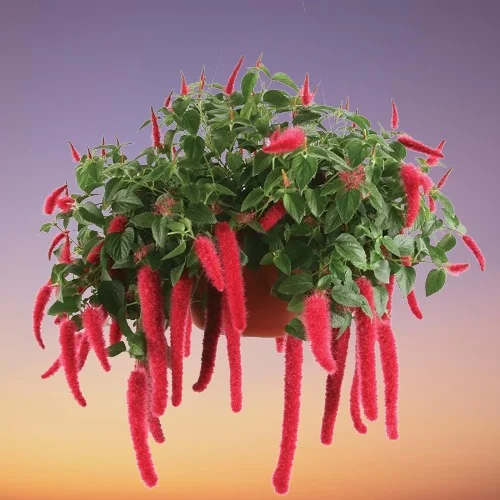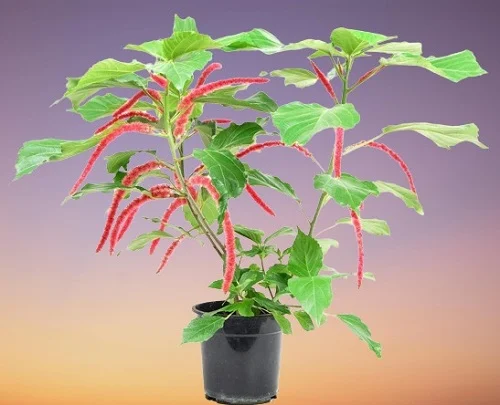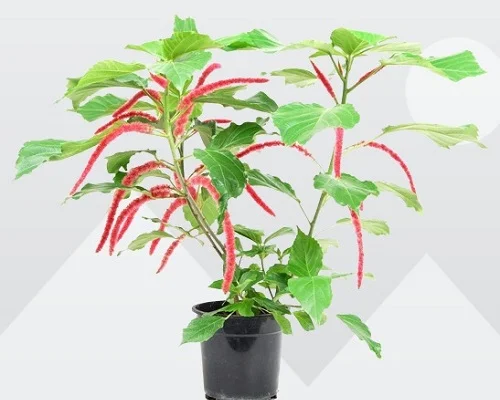10 Reasons Why Chenille Plant is Not Blooming and How to Fix Them
Some links in this post may be affiliate links
Chenille Plant is not blooming due to too little light, nutrients deficiency, lack of pruning, pests infestations, low humidity, drafts, inconsistent watering, salts buildup among others.
Chenille Plant which goes by the botanical name, Acalypha hispida, is a popular indoor plant because of its pendulous, brilliantly-colored, furry flowers.
Acalypha hispida blooms best in bright indirect light, average warmth of 18-280C, humidity of 55-70% and moderately moist, rich, well-drained coupled with fortnightly feeding in the growing season. Learn how to grow and care for Chenille Plant.
When these conditions are not met, the plant may not flower with the pendulous, brilliantly colored, furry flowers. Below are 10 reasons why your Chenille Plant is not blooming and how to coax it to bloom.

10 Reasons Chenille Plant is Not Flowering and Remedies
1. Too little light
Enough light is necessary for photosynthesis, the process by which plants make food required for growth and energy. If the light is too little, the plant cannot make adequate food for growth and development which results in stunted growth and lack of blooms.
How to fix itChenille Plant thrives in bright indirect light (dappled light). Position it infront of a brightly-lit window or instal grow lights if the natural lighting is inadequate.
Rotate the pot regularly to make sure that the plant absorbs enough light for photosynthesis on all sides for a balanced growth as well as prevent legginess.
2. Nutrients deficiency
Underfeeding a Chenille Plant implies that the plant is not getting enough nutrients needed for growth which leads to stunted growth and lack of blooms.
Overfeeding with cause the roots to die due to fertilizer burn. This means that the roots cannot take up nutrients and water required for photosynthesis, thus, growth reduces causing the plant not to flower.
How to fix itFeed your Chenille Plant with a phosphorous-rich, water-soluble fertilizer every 2-3 weeks in spring and summer to encourage flowering. Ensure to follow the maufacturer's instructions on the label.
Do not feed in fall and winter to prevent fertilizer burn as growth is minimal at this time.
3. Lack of pruning
Pruning is an important practice for a Chenille Plant to keep it neat, discourage pests and diseases, control growth and encourage blooming. Left unpruned blooming will be reduced.
How to fix itRemove dead leaves and flowers from your Chenille Plant to keep it neat and minimize pests and diseases.
Cutback the stems after flowering to about 12 inches above the soil to control growth, encourage a compact growth and boost blooming in the next season. Use a sharp, clean pair of pruning scissors to minimize injuries.

4. Pest infestations
Chenille Plant is prone to mealybugs, whiteflies and spidermites. These sap-sucking insects will cause the plant to become dehydrated resulting in reduced growth and blooming.
How to fix itMaintain your Chenille Plant healthy at all times by giving it the right growing conditions.
To reduce pest infestations raise the humidity as these pests are attracted by dry growing conditions.
Keep the plant well pruned by removing spent flowers, dead and yellow foliage to discourage infestations by these pesky pests.
Regularly inspect the plant for these pests and carry out timely control if you spot any.
If infested, isolate the infested plant to minimize spread to other plants and treat it with insecticidal soap or neem oil. Be careful to follow the manufacturer's instructions.
5. Poor quality soil
Soil that does not drain freely will easily become compacted or soggy which will lead to stunted growth and lack of blooming.
How to fix itPot your Chenille Plant in rich, well-draining soils to prevent waterlogging. A blend of 2 parts all purpose potting mix and 1 part perlite or vermiculite (for drainage) is perfect for this plant.
6. Low humidity
Too low humidity due to dry air will negatively affect growth resulting in brown leaf tips, reduced growth, leaf drop and lack of blooms.
How to fix itChenille Plant blossoms in a humidity of 55-70%. To upscale humidity, set the pot on a wet pebble tray, use a humidifier, group the plants together or grow the plant in a well-lit bathroom.

7. Being extremely pot-bound
Chenille Plant flowers best when slightly pot-bound but when extremely pot-bound, growth suffers resulting in lack of blooms.
This is because the roots have filled the pot and there is very little soil to hold water when watered. Since there is no water to take up for food making, growth and blooming stop due to lack of enough food.
How to fix itRepot your Chenille Plant into a pot one size larger when you spot a lot of roots growing through the drainage hole.
You may also divide the plant into several sections to propagate new plants.
Thereafter, repot the plant at the beginning of the growing season when extremely pot-bound. Use a pot with a drainage hole and well-draining soil. Check out these pots with a drainage hole on Amazon.
8. Drafts
Drafts on your Chenille Plant will result in extreme temperatures; either too cold or too hot temperatures which reduce growth and flowering.
How to fix itChenille Plant flourishes in an average warmth of 18-280C. Keep it away from sources of drafts like windy windows and doors, AC units, hot surfaces, heating units, hot stoves and other others.
9. Inconsistent watering
Underwatering implies that there is too little moisture in the soil for photosynthesis resulting in slowed growth and lack of blooming.
Overwatering causes the death of the roots due to lack of oxygen. When the roots die, the plant cannot take up water and therefore it cannot make food for growth and flowering.
How to fix itDo not water on a schedule. Water your Chenille Plant when the top 2-3 inches of soil begin to dry out and never allow the soil to dry out completely for prolonged periods of time.
10. Salts buildup
Accumulation of salts in the soil will cause the roots to die. As such the plant cannot take up water to the leaves for food making which leads to reduced growth and flowering.
These excess salts and chemicals may originate from watering with hard water or from the fertilizers used to feed the plant.
How to fix itOccasionally, flush out accumulated salts by running a stream of water through the soil until it drains through the drainage hole. Allow the stream of water to run for some time and repeat the process several times to clear most of the salts.
You liked it? Share on social media.
Related Content
Amazon Associates Disclosure
Homeplantsguide.com is a participant in the Amazon Services LLC Associates Program, an affiliate advertising program designed to provide a means for sites to earn advertising fees by advertising and linking to amazon.com.


